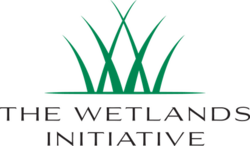The Wetlands Initiative facts for kids
 |
|
| Founded | 1994 (operations began in 1995) |
|---|---|
| Type | Nonprofit conservation organization |
| Focus | Wetland conservation |
| Headquarters | Chicago, Illinois, United States |
|
Area served
|
Midwestern United States |
|
Executive director and president
|
Paul Botts |
|
Staff (2019)
|
27 |
The Wetlands Initiative (or TWI) is a special group that works to protect nature. It's a non-profit organization, which means it doesn't make money for owners but uses it to help its cause. TWI is based in Chicago, Illinois, USA.
This group works with other non-profit organizations, government groups, and local communities. Their main goal is to bring back and study wetland areas in the Midwestern United States. TWI dreams of "A world with plentiful healthy wetlands improving water quality, climate, biodiversity, and human well-being." This means they want lots of healthy wetlands to help clean water, improve the climate, protect different kinds of plants and animals, and make life better for people.
Contents
History of The Wetlands Initiative
The Wetlands Initiative officially started in 1994, and they began their work in 1995. In 2020, TWI celebrated 25 years of helping wetlands. They shared two short films to mark this special anniversary. One film honored Al Pyott, who helped start TWI and passed away in June 2020. Another film, called "Wetlands: Havens of Life," was a video essay by author Julian Hoffman.
Wetland Restoration Projects
The Wetlands Initiative works on many exciting projects to restore and protect wetlands. These projects help bring back important natural areas.
Dixon Waterfowl Refuge
TWI owns and manages the Dixon Waterfowl Refuge near Hennepin, Illinois. This area used to be lakes and wetlands connected to the Illinois River. But in the early 1900s, it was drained and used for farming for over 75 years.
TWI bought the land in 2000. They wanted to show that even land farmed for a long time could become a healthy wetland again. Restoration work started in the spring of 2001. By 2004, the National Audubon Society called the refuge an "Important Bird Area." This means it's a very important place for birds.
In 2012, the Dixon Waterfowl Refuge was named a "Wetlands of International Importance." This is a special title given under the global Ramsar Convention. It was only the 34th place in the United States to get this recognition. Part of the refuge, about 26 acres, has a rare seep. This is the largest high-quality seep in the Illinois River Valley. It is protected as an Illinois Nature Preserve.
Midewin National Tallgrass Prairie
TWI is a key partner at Midewin National Tallgrass Prairie. This is a site managed by the United States Forest Service. The area has rare dolomite prairies and sedge meadows. In 2013, a part of Midewin that TWI and Openlands helped restore won an award. It was recognized for its conservation and native landscaping efforts.
Calumet Region Restoration
Starting in 2016, TWI and its partners began big restoration projects in the Calumet Region. This area is located across two states.
At Indian Ridge Marsh, a Chicago Park District site, partners are working to create healthy marsh and prairie habitats. For many years, this site was used as a dump for waste from steel mills. In Northwest Indiana, TWI helped create a partnership to restore wetlands. They are bringing back natural water flow and native plants along a 2,000-acre part of the Little Calumet River. This river section was cleared for flood control. These areas were known to be challenging but important places to restore.
Smart Wetlands Project
TWI is also working to help farmers in Illinois. They are trying to reduce agricultural runoff from farms. This runoff, which contains pollutants, is a big reason for the Gulf Coast dead zone. A dead zone is an area in the ocean where there is very little oxygen, making it hard for sea life to survive.
The "Smart Wetlands" project encourages farmers to build constructed wetlands on their land. These special wetlands help clean the water before it flows into the Illinois River. TWI works closely with groups like the Illinois Sustainable Ag Partnership and farm organizations. As of late 2020, four of these wetlands had been built. Two are on farms in Bureau County, one is in Livingston County, and one is at Illinois Central College. This college has a busy program for students studying farming.


